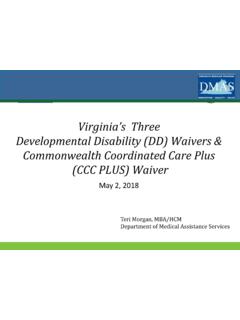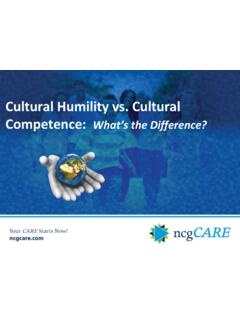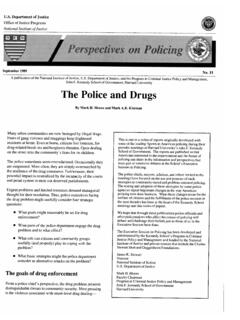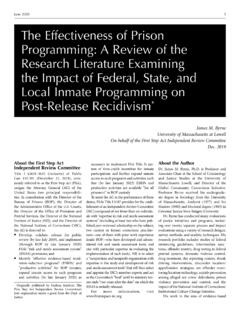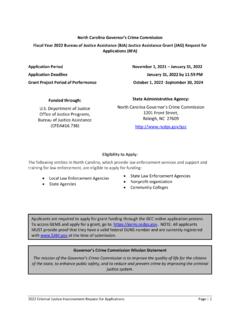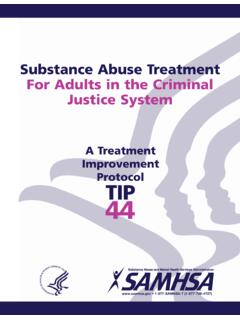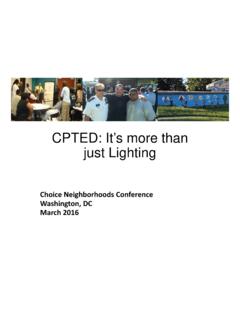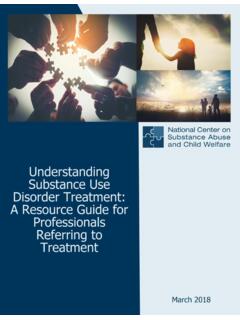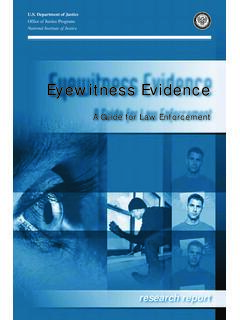Transcription of Multisystemic Therapy (MST) Overview
1 MultisystemicTherapy (MST) Overview Jeff Randall, Based Services, Inc.,Jennifer Smith Ramey, Behavioral HealthMultisystemic Therapy (MST) Overview1 What is MST ? Community-based, family-driven treatment for antisocial/delinquent behavior in youth Focus is on Empowering caregivers (parents) to solve current and future problems MST client is the entire ecology of the youth -family, peers, school, neighborhood Highly structured clinical supervision and quality assurance processes Multisystemic Therapy (MST) Overview2 Standard MST Referral Criteria (ages 12-17)Inclusionary Criteria Youth at risk for placement due to anti-social or delinquent behaviors, including substance abuse Youth involved with the juvenile justice system Youth who have committed sexual offenses in conjunction with other anti-social behaviorExclusionary Criteria Youth living independently Sex offending in the absence of other anti social behavior Youth with moderate to severe autism (difficulties with social communication, social interaction, and repetitive behaviors)
2 Actively homicidal, suicidal or psychotic Youth whose psychiatric problems are primary reason leading to referral, or have severe and serious psychiatric problems3 Multisystemic Therapy (MST) OverviewFamilies as the Solution MST focuses on families as the solution Families are full collaborators in treatment planning and delivery with a focus on family members as the long-term change agents Giving up on families, or labeling them as resistant or unmotivated is not an option MST has a strong track record of client engagement, retention, and satisfactionMultisystemic Therapy (MST) Overview4 How Does MST Work?Key Points: Theoretical And Research Underpinnings MST Theory of Change and Assumptions How is MST Implemented? Multisystemic Therapy (MST) Overview5 Theoretical Underpinnings Children and adolescents live in a social ecology of interconnected systems that impact their behaviors in direct and indirect ways These influences act in both directions (they are reciprocal and bi-directional)Based on social ecological theory of Uri BronfenbrennerMultisystemic Therapy (MST) Overview6 Social Ecological Model CommunityProvider AgencySchoolNeighborhoodPeersExtended FamilySiblingsCHILDF amily MembersCaregiver7 Causal Models of Delinquency and drug Use.
3 Common Findings of 50+ Years of ResearchFamilySchoolDelinquentPeersDelin quentBehaviorPrior DelinquentBehaviorNeighborhood/ CommunityContext8 Research on Delinquency and drug Use Family Level Poor parental supervision Inconsistent or lax discipline Poor affective relations between youth, caregivers, and siblings Parental substance abuse and mental health problemsMultisystemic Therapy (MST) Overview9 Research on Delinquency and drug Use (Cont.)Peer Level Association with drug -using and/or delinquent peers Poor relationship with peers, peer rejection Association with antisocial peers is the most powerful direct predictor of delinquent behavior! Multisystemic Therapy (MST) Overview10 Research on Delinquency and drug Use (Cont.)School Level Academic difficulties, low grades, having been retained Behavioral problems at school, truancy, suspensions Negative attitude toward school Attending a school that does not flex to youth needsMultisystemic Therapy (MST) Overview11 Research on Delinquency and drug Use (Cont.)
4 Community Level Availability of weapons and drugs High environmental and psychosocial stress (violence) Neighborhood transience neighbors move in and outMultisystemic Therapy (MST) Overview12 Research on Delinquency and drug Use (Cont.) Youth Level ADHD, impulsivity Positive attitude toward delinquency and substance use Lack of guilt for transgressions Negative affectMultisystemic Therapy (MST) Overview13 MST Theory of ChangeMultisystemic Therapy (MST) Overview14 MSTI mproved Family FunctioningPeers SchoolReduced Antisocial Behavior and Improved FunctioningCommunityMST Assumptions Children s behavior is strongly influenced by their families, friends and communities (and vice versa) Families and communities are central and essential partners and collaborators in MST treatment Caregivers/parents want the best for their children and want them to grow to become productive adultsMultisystemic Therapy (MST) Overview15 MST Assumptions (Cont.)
5 Families can live successfully without formal, mandated services Change can occur quickly Professional treatment providers should be accountable for achieving outcomes Science/research provides valuable guidanceMultisystemic Therapy (MST) Overview16 How is MST Implemented?Intervention strategies: MST draws from research-based treatment techniques Behavior Therapy Parent management training Cognitive behavior Therapy Pragmatic family therapies Structural Family Therapy Strategic Family Therapy Pharmacological interventions ( , for ADHD) Multisystemic Therapy (MST) Overview17 How is MST Implemented?(Cont.) Single therapist working intensively with 4 to 6 families at a time Team of 2 to 4 therapists plus a supervisor 24 hr/ 7 day/ week team availability: on call system 3 to 5 months is the typical treatment time (4 months on average across cases) Work is done in the community, home, school, neighborhood: removes barriers to service access Multisystemic Therapy (MST) Overview18 How is MST Implemented?
6 (Cont.) MST staff deliver all treatment typically no or few services are brokered/referred outside the MST team Never-ending focus on engagement and alignment with primary caregiver and other key stakeholders ( probation, courts, children and family services, etc.) MST has strong track record of client retention and satisfaction with MST MST staff must be able to have a lead clinical role, ensuring services are individualized to strengths and needs of each youth/familyMultisystemic Therapy (MST) Overview19 quality Assurance and Continuous quality improvement in MSTGoal of MST Implementation: Obtain positive outcomes for MST youth and their familiesQA/QI Process: Training and ongoing support (orientation training, boosters, weekly expert consultation, weekly supervision) Organizational support for MST programs Implementation monitoring (measure adherence and outcomes, work sample reviews) Improve MST implementation as needed, using feedback from training, ongoing support, and measurement20 Multisystemic Therapy (MST) OverviewCore Elements of MSTKey Points.
7 MST Treatment Principles MST Analytic Process MST quality Assurance SystemMultisystemic Therapy (MST) Overview21 MST Treatment Principles Nine principles of MST intervention design and implementation Treatment fidelity and adherence is measured with relation to these nine principlesMultisystemic Therapy (MST) Overview229 Principles of the and Strength , Action-Oriented & & Finding the Fit: The primary purpose of assessment is to understand the fit between the identified problems and their broader systemic contextKim s Substance AbuseDrug using Peers Access to marijuanaKim can buy drugs with cash given to her by relatives Uses after conflicts with motherLack of consequences for useBoredom, doesn t have other things to doModeling of use in community (peers and adults)Low monitoring by mother24 Principles of MST (Cont.) & Strength FocusedTherapeutic contacts should emphasize the positive and should use systemic strengths as levers for Therapy (MST) Overview25 Principles of MST (Cont.)
8 ResponsibilityInterventions should be designed to promote responsibility and decrease irresponsible behavior among family , Action-oriented & Well-definedInterventions should be present-focused and action-oriented, targeting specific and well-defined Therapy (MST) Overview265. Targeting Sequences: Interventions should target sequences of behavior within and between multiple systems that maintain identified problems (cont.)Mom asks youth to do homework and clean roomYouth says he ll do it in a minuteMom makes a second request; youth ignoresStep-father intervenes: listen to your mom Youth states get out of my face, you re not my dad Step father starts shouting: you live in my house, do it now Mom gets in the middle to stop verbal argument and gets pushed Mom hits her head, step-father is furiousYouth runs to room, and locks doorStep-father calls policeYouth arrested for assault charge27 Principles of MST (Cont.) AppropriateInterventions should be developmentally appropriate and fit the developmental needs of the Therapy (MST) Overview28 Principles of MST (Cont.)
9 7. Continuous EffortInterventions should be designed to require daily or weekly effort by family Evaluation and AccountabilityIntervention efficacy is evaluated continuously from multiple perspectives, with providers assuming accountability for overcoming barriers to successful Therapy (MST) Overview29 Principles of MST (Cont.)9. GeneralizationInterventions should be designed to promote treatment generalization and long-term maintenance of therapeutic change by empowering care givers to address family members needs across multiple systemic Therapy (MST) Overview30 Environment of Alignment and Engagementof Family and Key ParticipantsMeasureRe-evaluatePrioritize DoIntermediaryGoalsInterventionDevelopme ntMST Conceptualizationof Fit Assessment ofAdvances & Barriers toIntervention EffectivenessInterventionImplementationM STA nalyticalProcessReferralBehaviorOverarch ingGoalsDesired Outcomesof Family and OtherKey Participants31 MST Ultimate Outcomes2015 MSTI Data ReportAT HOME90%These results are based on a comprehensive review of the 11,958 cases* ( of 13,995 cases referred for treatment) that were closed for clinical reasons ( , completed treatment, low engagement, or placed).
10 IN SCHOOL/ Therapy (MST) Overview32 MST Staff TrainingPurpose:To achieve positive outcomes through the implementation of training and supervision protocols used in the clinical trials of MST. On-the-job training (weekly on-site supervision and MST expert case review) 5-day Orientation training Quarterly on-site booster training Development planning for all professionalsMultisystemic Therapy (MST) Overview33 Influences of Other System Stakeholders Clearly defined target population, program goals and referral process Funding structure in place Ability of MST therapist to take the lead in clinical decision making Key stakeholders usually include: Juvenile Justice, Family court , Mental Health, Social Welfare, School systems, parent groupsMultisystemic Therapy (MST) Overview34 Why is MST Successful? Treatment targets known causes of delinquency: family relations, peer relations, school performance, community factors Treatment is family-driven and occurs in each youth s natural environment Significant energies are devoted to developing positive interagency relations MST personnel are well trained and supported Providers are accountable for outcomes Continuous quality improvement occurs at all levels35 Multisystemic Therapy (MST) OverviewMST in Virginia36 Where to find MST in VirginiaMultisystemic Therapy (MST) Overview37 MST in Virginia.
